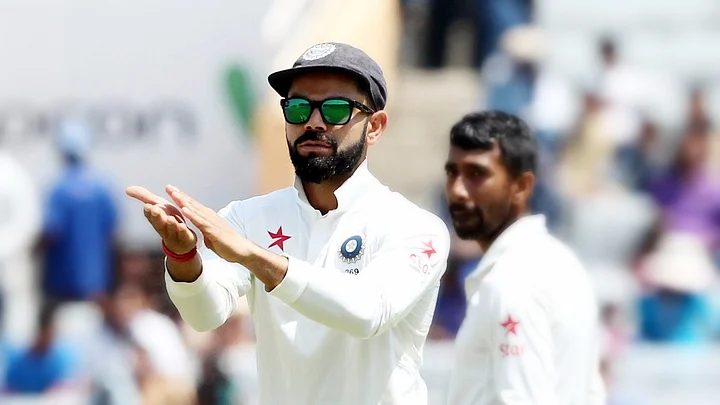It took the Indian team only 83 minutes on the fourth day of the Dharamsala Test to cross the finish line and snatch back the Border-Gavaskar Trophy.
The pressure had been on Team India in the Final Test; the series was on the line, they were without the services of their captain, and the surface at the HPCA Stadium in Dharamsala was closer to what the Australians play at home than what India is accustomed to.
Swatting all those odds aside and led ably by Ajinkya Rahane, Team India accomplished the job in style. At 10:53 am, when KL Rahul whipped one off his pads and raced across for a brace, the job had been done. India had won the deciding Test match in Dharamsala by 8 wickets, with it the series 2-1 and reclaimed the Border Gavaskar Trophy.
After the 2-1 series win against Australia, India have filled the final block in an incomplete picture; they now hold the rubber against all the nine teams playing Test cricket.
Such a feat has only been accomplished on a couple of occasions previously in Test cricket history.
The series win against Australia should count among India’s finest ever, for more reasons than one.
Among them, the fact that each challenge posed by the Aussies, found a capable answer from the Indian camp. And it wasn't always captain Virat Kohli with the answers.
After all, for the first half of the home season, India had ended in the winner’s column due to the performances of three individuals: Virat Kohli, Ravichandran Ashwin and Ravindra Jadeja. There were timely contributions from others, but the contributions these three towered over the rest.
No Virat? No Problem
Prior to the series against Australia, Virat Kohli was the only Indian player to score in excess of 1000 Test runs in the home season. He had even scored double centuries in each of the four-previous series. Given the form he was in, it was expected that he would dominate the Australian attack too.
But that was not to be. The Indian captain only managed 46 runs in the first three Test matches – with a highest score of 15 – before a shoulder injury ruled him out of the decider.
It was Virat Kohli’s poorest-returns in a Test series (excluding one-off Test matches).
Yet, for Team India to stage a comeback and win the series, is extremely satisfying and speaks volumes of how much talent there is in the dressing room.
Two batsmen – KL Rahul and Cheteshwar Pujara – were consistent through the series and became the pillars of the team. But one must not forget the runs contributed by the rest of the cast.
Rahane scored an important half-century in the second innings in Bengaluru, Wriddhiman Saha scored a century batting at number eight and bailed the team from a difficult position in the third Test match in Ranchi, and in the decider in Dharamsala, Ravindra Jadeja scored a crucial 63 lower down the order and helped the team to a slender-yet-crucial first innings lead.
It bodes well for Team India that despite the team’s batting mainstay not firing, several individuals have put up their hands and made crucial contributions.
On the bowling front, one expected Ravichandran Ashwin would be Australia’s tormenter-in-chief; the off-spinner was the top-ranked bowler in the world and possibly at the peak of his bowling form heading into the series. However, fatigue possibly caught up with him towards the end of a long home season; the 30-year old picked up 15 wickets in the first two Test matches against Australia, and could only add six more in the last two Test matches of the season.
Enter Ravindra Jadeja, who took centerstage and helped dismantle the Australians. In the final two Test matches, the left-arm spinner picked up 13 wickets and even climbed to the perch of the ICC’s Test Bowling rankings.
The two Yadav’s played a crucial role in India’s success too; Umesh rattled the Aussies in the final Test and finished with career-best-series-returns of 17 wickets, while debutant Kuldeep Yadav bamboozled the Aussies in the first innings in Dharamsala and should be singled out for giving India the breakthrough that gave India the opportunity to force a way back in the Test.
Bhuvneshwar Kumar picked up only two wickets – but one of those was the important wicket of the man-in-form Steven Smith.
If ever a series was won on the basis of contributions from ‘all and sundry’, this has to be one of them.
Ajinkya Rahane was brilliant too - stepping into the shoes of ‘Virat Kohli - The Captain’; the Mumbai lad had never before captained a team in first-class cricket, but he got most of his decisions absolutely right in Dharamsala.
Starting with the XI that he named – which included handing a debut to Kuldeep Yadav, to getting his field placements and bowling changes, Rahane was spot on on most occasions.
India have met a lot of success during this home season – having defeated New Zealand, England, Bangladesh and Australia. But everyone involved with Indian cricket would have learnt plenty from the decider at Dharamsala – it showed the character of the team and gave an insight into what this team is made up of. The future is certainly looking good for Indian cricket.
Join us on WhatsApp. Type “JOIN” and send to 9910181818
(At The Quint, we question everything. Play an active role in shaping our journalism by becoming a member today.)
